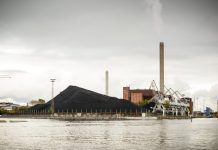In the modern energy system, upwards of 10% of the total primary energy supply is expended to find, develop, extract, transform, and transport energy carriers to end-users 1. Some particularly challenging resources, such as heavy oil, require an even larger fractional expenditure for their extraction and processing. This energy expenditure within the energy sector and the wider economy has economic, social and environmental consequences, and thus attracted much interest in the wake of the 1970’s Arab oil embargo. Larger energy expenditures to support the activities of the energy sector also necessitate additional capital investment for increased throughput of energy per unit of final energy product delivered to non-energy sectors (e.g., to final consumers).
Net energy analysis (NEA) rose and then fell from favour in the energy analysis community, with high interest occurring from the years 1975 to 1985 and again in recent years – both times of high oil prices. Interest in NEA declined in the mid-1980s, as the belief grew that the method provided no additional information beyond economic analyses 3, 4.
There has been a recent resurgence in interest in NEA, focused mainly on a particular metric, energy return on investment (EROI). This recent interest has been spurred by concerns over oil depletion 5-7 and interest in the fundamental energetics of the transition to renewable resources 8-10.
NEA is a broad class of methods used to determine the effectiveness of energy capture and conversion systems 2. The end result from NEA is often calculation of an energy return ratio (ERR), of which EROI is one example. These ERRs compare the amount of energy expended in extracting and upgrading an energy resource to the amount of useful energy provided to society. Numerous ERR’s exist, and the usefulness of a given ratio depends on its formulation and the question of concern 11, 12.
ERR’s can help illuminate two important aspects of an energy system: (1) the quality of the energy resource being extracted, and (2) the ingenuity with which humans extract that energy. A shift from high-quality resources (e.g., light, sweet conventional oil) to low-quality resources (e.g., heavy oil) affects the efficiency of extraction, the cost of energy, and the overall environmental impacts from our energy system. By extension, the sophistication with which we extract and convert energy affects the end cost to users and the environmental profile of all economic activities.
In the past ten years, production of both Canadian oil sands and ‘shale oil’ (actually tight oil) has seen impressive growth in production. In fact, production of shale oil from the Bakken, ND and Eagle Ford, TX has reversed a four-decade decline in US production of oil, spurred primarily by historically high oil prices. At oil prices north of 75 USD per barrel (as was the case for much of the past 5 years) both oil sands and shale oil seemed like viable resources. Since the recent drop in the oil price to below 50 or 40 USD/barrel, producers of both resources are struggling 13, 14. From an economic perspective then, these two resources appear very similar. If net energy analysis offers little insight, beyond traditional economic analysis, is there nothing that the investor or policymaker can learn from the net energy analyst?
Dr. Adam Brandt from Stanford University has spent the last five years analyzing fossil-fuel systems. His work indicates that the fractional energy expenditure of Canadian oil sands is between 30-60% (or between 10-50% if self-use of bitumen is not included), whereas the figure for shale oil is more like 2% 15, 16.
The production of crude oil from oil sands is comprised of a sequence of highly energy-intensive stages which have changed little since the resource was first tapped back in the Sixties, suggesting that there is little room for improvement in the physical process. As such, it is likely that the high cost of producing oil from oil sands is constrained by fundamental, inescapable, physical reality. On the other hand, there is no such physical constraint on the cost of producing shale oil, as evidenced by the low energetic cost – drilling and fracturing rock doesn’t take that much energy. In this case, the financial picture is likely skewed by the fact that hydraulic fracking is a relatively new technology with only a few companies providing the service. Since those companies are in high demand, they can charge a large premium.
Looking to the future, we can expect to see the price of fracking services decline as more providers join the market or, as is happening already, delivered fracking service contracts are being renegotiated in the face of lower oil prices. Either way, the production cost of shale oil is likely to come down; an insight gained by looking at physical performance metrics, not financial ones.
Other cases exist were relying solely on financial analyses skews the picture, particularly when subsidies, labour-intensive processes or very early-stage technologies come into play. For example, a recent study of a photo-electrochemical cell for producing hydrogen-powered by solar energy (artificial photosynthesis) would struggle to break even from an energy perspective, even under generous assumptions of performance 17. The constraint came primarily from the materials needed to build out the large areas required. Even given impressive solar-to-hydrogen efficiencies and the lure of ‘free fuel from sunlight’ this is an investment that would be unlikely to pay off in the long run.
Evidently then, there are clear benefits to supplementing financial analyses with one based on a physical understanding, such as net energy analysis. Both investors and policymakers would do well to consult with such analysts, especially in volatile or emerging technology markets.
References:
1 Robert U Ayres. Energy and economic growth. In Sustainable Energy Production and Consumption, pages 1-23. Springer, 2008
2 R Herendeen and J Cleveland Cutler. Net energy analysis: concepts and methods. Encyclopedia of Energy, 4:283-289, 2004.
3 David A Huettner. Net energy analysis: an economic assessment. Science; (United States), 192(4235), 1976.
4 David A Huettner. Energy analysis and ultimate limits. In Fred S Roberts and Wendell W Waterman, editors, Energy modelling and net energy analysis: symposium papers presented August 21-25, 1978, Colorado Springs, Colorado. The Institute, 1978.
5 Cutler J Cleveland. Energy quality and energy surplus in the extraction of fossil fuels in us. Ecological Economics, 6(2):139-162, 1992.
6 Cutler J Cleveland. Net energy from the extraction of oil and gas in the united states. Energy, 30(5):769-782, 2005.
7 Megan C Guilford, Charles AS Hall, Peter O’Connor, and Cutler J Cleveland. A new long term assessment of energy return on investment (EROI) for US oil and gas discovery and production. Sustainability, 3(10):1866-1887, 2011.
8 K Knapp and T Jester. An empirical investigation of the energy payback time for photovoltaic modules. Solar Energy, 71(3):165-172, 2001.
9 Sergio Pacca, Deepak Sivaraman, and Gregory A Keoleian. Parameters affecting the life cycle performance of PV technologies and systems. Energy Policy, 35(6):3316-3326, 2007.
10 Ioannis N Kessides and David C Wade. Towards a sustainable global energy supply infrastructure: Net energy balance and density considerations. Energy Policy, 39(9):5322-5334, 2011.
11 Albert G Melcher, K Maddox, C Prien, T Nevens, V Yesavage, P Dickson, J Fuller, W Loehr, R Baldwin, and R Bain. Net energy analysis: An energy balance study of fossil fuel resources. Technical report, Colorado Energy Research Institute, PO Box 366, Golden, CO 80401, 1976.
12 David V Spitzley and Gregory A Keoleian. Life cycle environmental and economic assessment of willow biomass electricity: A comparison with other renewable and non-renewable sources. Ann Arbor, MI: Center for Sustainable Systems, University of Michigan, 2004.
13 Chester Dawson, Canadian Oil-Sands Producers Struggle, Wall Street Journal, Aug 19, 2015. http://www.wsj.com/articles/oilsandsproducers-struggle-1440017716
14 FACTBOX-Breakeven oil prices for U.S. shale: analyst estimates, Reuters, Oct 23, 2014. http://www.reuters.com/article/2014/10/23/idUSL3N0SH5N220141023
15 Adam R. Brandt, Jacob Englander, and Sharad Bharadwaj. The energy efficiency of oil sands extraction: Energy return ratios from 1970 to 2010. Energy 55, 693-702, 2013.
16 Adam R. Brandt, Net energy returns from unconventional oil: Implications for the environment, GCEP Net Energy Analysis Workshop, Mar 31-Apr 1, p.14, 2015. http://gcep.stanford.edu/pdfs/events/workshops/Brandt_Oil_Net_Energy_Environment_v6.pptx.pdf
17 Pei Zhai, Haussener, S., Ager, J., Sathre, R., Walczak, K., Greenblatt,J., & McKone, T. Net primary energy balance of a solardrivenphotoelectrochemical water-splitting device. Energy &Environmental Science, 6(8), 2380-2389, 2013.
Michael Carbajales-Dale
Asst. Professor in Environmental Engineering & Earth Sciences
Clemson University
Tel: +01 864 656 0523
madale@clemson.edu











